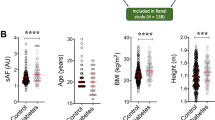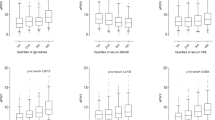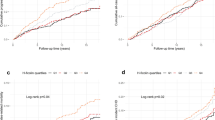Abstract
Background/Objectives:
The level of skin autofluorescence (AF) at a given moment is an independent predictor of mortality in hemodialysis (HD) patients. Skin AF is a measure of the accumulation of advanced glycation end products (AGEs). The aim of the study was to estimate the influence of nutrition on the 1-year increase of skin AF (ΔAF) in HD patients.
Subjects/Methods:
A total of 156 HD patients were enrolled in this study. Skin AF, body mass index (BMI), superoxide dismutase, myeloperoxidase, C-reactive protein, inter-cellular adhesion molecule-1, von Willebrand factor and heart-type fatty acid-binding protein were measured four times at intervals of approximately half a year. Data from the monthly routine blood analysis were also used. Daily calorie, protein and AGE intakes were assessed from food recordings over a period of 1 week.
Results:
A J-shaped relation was found between baseline BMI and ΔAF (P=0.01). The lowest point of the J-shaped curve is found for BMI=24.3 kg/m2. In the univariate analysis of the contributors to the 1-year ΔAF, we found that beside BMI=24.3 kg/m2, AGE and calorie intakes, as well as myeloperoxidase and HD vintage, had a P <0.10. The sole independent predictor of the 1-year ΔAF was BMI=24.3 kg/m2 (P=0.01).
Conclusions:
It appears that calorie, protein and AGE intakes hardly influence the 1-year ΔAF in HD patients. BMI of HD patients of around 24 kg/m2 resulted in a lower 1-year ΔAF.
This is a preview of subscription content, access via your institution
Access options
Subscribe to this journal
Receive 12 print issues and online access
$259.00 per year
only $21.58 per issue
Buy this article
- Purchase on Springer Link
- Instant access to full article PDF
Prices may be subject to local taxes which are calculated during checkout

Similar content being viewed by others
Change history
04 March 2015
This article has been corrected since advance online publication and a corrigendum is also printed in this issue
References
Goldberg T, Cai W, Peppa M, Dardaine V, Baliga BS, Uribarri J et al. Advanced glycoxidation end products in commonly consumed foods. J Am Diet Assoc 2004; 104: 1287–1291.
Sebekova K, Faist V, Hofmann T, Schinzel R, Heidland A . Effects of a diet rich in advanced glycation end products in the rat remnant kidney model. Am J Kidney Dis 2003; 41: S48–S51.
Zheng F, He C, Cai W, Hattori M, Steffes M, Vlassara H . Prevention of diabetic nephropathy in mice by a diet low in glycoxidation products. Diabetes Metab Res Rev 2002; 18: 224–237.
Lin RY, Reis ED, Dore AT, Lu M, Ghodsi N, Fallon JT et al. Lowering of dietary advanced glycation end-products (AGE) reduces neointimal formation after arterial injury in genetically hypercholesterolemic mice. Atherosclerosis 2002; 163: 303–311.
Calder PC, Ahluwalia N, Brouns F, Buetler T, Clement K, Cunningham K et al. Reduced oxidant stress and extended lifespan in mice exposed to a low glycotoxin diet: association with increased AGER1 expression. Am J Pathol 2007; 170: 1893–1902.
Uribarri J, Cai W, Ramdas M, Goodman S, Pyzik R, Chen X et al. Dietary factors and low-grade inflammation in relation to overweight and obesity. Br J Nutr 2011; 106: S5–78.
Uribarri J, Cai W, Ramdas M, Goodman S, Pyzik R, Chen X et al. Restriction of advanced glycation end products improves insulin resistance in human type 2 diabetes: potential role of AGER1 and SIRT1. Diabetes Care 2011; 34: 1610–1616.
Sebekova K, Somoza V, Jarcuskova M, Heidland A, Podracka L . Plasma advanced glycation end products are decreased in obese children compared with lean controls. Int J Pediatr Obes 2009; 4: 112–118.
Maza MP, Bravo A, Leiva L, Gattas V, Petermann M, Garrido F et al. Fluorescent serum and urinary advanced glycoxidation end-products in non- diabetic subjects. Biol Res 2007; 40: 203–212.
Schwenger V, Morath C, Schonfelder K, Klein W, Weigel K, Deppisch R et al. An oral load of the early glycation compound lactuloselysine fails to accumulate in the serum of uraemic patients. Nephrol Dial Transpl 2006; 21: 383–388.
Vlassara H, Cai W, Crandall J, Goldberg T, Oberstein R, Dardaine V et al. Inflammatory mediators are induced by dietary glycotoxins, a major risk factor for diabetic angiopathy. Proc Natl Acad Sci USA 2002; 99: 15596–15601.
Arsov S, Graaff R, van Oeveren W, Stegmayr B, Sikole A, Rakhorst G, Smit AJ . Advanced glycation end-products and skin autofluorescence in end-stage renal disease: a review. Clin Chem Lab Med 2013; 52: 1–10.
Uribarri J, Peppa M, Cai W, Goldberg T, Lu M, Baliga S et al. Dietary glycotoxins correlate with circulating advanced glycation end product levels in renal failure patients. Am J Kidney Dis 2003; 42: 532–538.
Meerwaldt R, Graaff R, Oomen PH, Links TP, Jager JJ, Alderson NL et al. Simple non-invasive assessment of advanced glycation endproduct accumulation. Diabetologia 2004; 47: 1324–1330.
Meerwaldt R, Hartog JW, Graaff R, Huisman RJ, Links TP, den Hollander NC et al. Skin autofluorescence, a measure of cumulative metabolic stress and advanced glycation end products, predicts mortality in hemodialysis patients. J Am Soc Nephrol 2005; 16: 3687–3693.
Arsov S, Trajceska L, van Oeveren W, Smit AJ, Dzekova P, Stegmayr B et al. Increase in skin autofluorescence and release of heart-type fatty acid binding protein in plasma predicts mortality of hemodialysis patients. Artif Organs 2013; 37: E114–E122.
Jochemsen BM, Mulder DJ, Van Doormaal JJ, Mulder G, Volmer M, Graaff R, Smit AJ . Relation between food and drinking habits, and skin autofluorescence and intima media thickness in subjects at high cardiovascular risk. J Food and Nutr Res 2009; 48: 51–58.
American Diabetic Association. Revisions for the Clinical Practice Recommendations. Diabetes Care 2004; 27 (Suppl 1), S1–S137.
Arsov S, Graaff R, Morariu AM, van Oeveren W, Smit AJ, Busletic I et al. Does hepatitis C increase the accumulation of advanced glycation end products in haemodialysis patients? Nephrology Dial Transpl 2010; 25: 885–891.
The United States Department of Agriculture. Nutritive Value of Foods, 2002. Available at: http://www.ars.usda.gov/SP2UserFiles/Place/12354500/Data/hg72/hg72_2002.pdf.
World Health Organization Physical Status: the Use and Interpretation of Anthropometry. Report of a WHO Expert Committee. WHO Technical Report Series 854. World Health Organization: Geneva, Switzerland, 1995.
Koetsier M, Nur E, Han CM, Lutgers HL, Links TP, Smit AJ et al. Skin color independent assessment of aging using skin autofluorescence. Optics Express 2010; 18: 14416–14429.
Hemodialysis Adequacy 2006 Work Group. Clinical practice guidelines for hemodialysis adequacy, update 2006. Am J Kidney Dis 2006; 48(Suppl 1): 2–90.
Speakman JR, Westerterp KR . Reverse epidemiology, obesity and mortality in chronic kidney disease: modelling mortality expectations using energetics. Blood Purif 2010; 29: 150–157.
Arsov S, Graaff R, Morariu AM, van OW, Smit AJ, Busletic I et al. Does hepatitis C increase the accumulation of advanced glycation end products in haemodialysis patients? Nephrology Dial Transpl 2010; 25: 885–891.
Meerwaldt R, Hartog JW, Graaff R, Huisman RJ, Links TP, den Hollander NC et al. Skin autofluorescence, a measure of cumulative metabolic stress and advanced glycation end products, predicts mortality in hemodialysis patients. J Am Soc Nephrol 2005; 16: 3687–3693.
Klemm A, Franke C, Busch M, Muller A, Franke S, Lang D et al. Influence of hemodialysis membrane permeability on serum levels of advanced glycation end products (AGEs) and homocysteine metabolites. Clin Nephrol 2004; 61: 191–197.
Stein G, Franke S, Mahiout A, Schneider S, Sperschneider H, Borst S, Vienken J . Influence of dialysis modalities on serum AGE levels in end-stage renal disease patients. Nephrol Dial Transpl 2001; 16: 999–1008.
van Tellingen A, Schalkwijk CG, Teerlink T, Barto R, Grooteman MP, van der Ploeg T et al. Influence of different haemodialysis modalities on AGE peptide levels: intradialytic versus long-term results. Nephron Clin Pract 2005; 100: c1–c7.
Tessitore N, Lapolla A, Arico NC, Poli A, Gammaro L, Bassi A et al. Effect of protein leaking BK-F PMMA-based hemodialysis on plasma pentosidine levels. J Nephrol 2004; 17: 707–714.
Lin CL, Huang CC, Yu CC, Yang HY, Chuang FR, Yang CW . Reduction of advanced glycation end product levels by on-line hemodiafiltration in long-term hemodialysis patients. Am J Kidney Dis 2003; 42: 524–531.
Negrean M, Stirban A, Stratmann B, Gawlowski T, Horstmann T, Gotting C et al. Effects of low- and high-advanced glycation endproduct meals on macro- and microvascular endothelial function and oxidative stress in patients with type 2 diabetes mellitus. Am J Clin Nutr 2007; 85: 1236–1243.
Hartog JW, de Vries AP, Lutgers HL, Meerwaldt R, Huisman RM, van Son WJ et al. Accumulation of advanced glycation end products, measured as skin autofluorescence, in renal disease. Ann NY Acad Sci 2005; 1043: 299–307.
Matsumoto T, Tsurumoto T, Baba H, Osaki M, Enomoto H, Yonekura A et al. Measurement of advanced glycation endproducts in skin of patients with rheumatoid arthritis, osteoarthritis, and dialysis-related spondyloarthropathy using non-invasive methods. Rheumatol Int 2007; 28: 157–160.
Corstjens H, Dicanio D, Muizzuddin N, Neven A, Sparacio R, Declercq L, Maes D . Glycation associated skin autofluorescence and skin elasticity are related to chronological age and body mass index of healthy subjects. Exp Gerontol 2008; 43: 663–667.
Akiyama S, Inagaki M, Tsuji M, Gotoh H, Gotoh T, Gotoh Y, Oguchi K . mRNA study on Cu/Zn superoxide dismutase induction by hemodialysis treatment. Nephron Clin Pract 2005; 99: c107–c114.
ERA-EDTA. Renal replacement therapy in Europe—a summary of the 2010 ERA–EDTA Registry Annual Report, 2013.
Pawlak K, Pawlak D, Mysliwiec M . Impaired renal function and duration of dialysis therapy are associated with oxidative stress and proatherogenic cytokine levels in patients with end-stage renal disease. Clin Biochem 2007; 40: 81–85.
Dominguez-Rodriguez A, breu-Gonzalez P, Kaski JC . Diurnal variation of circulating myeloperoxidase levels in patients with ST-segment elevation myocardial infarction. Int J Cardiol 2009; 144: 407–409.
Sabry AA, Elbasyouni SR, Kalil AM, bdel-Rahim M, Mohsen T, Sleem A . Markers of inflammation and atherosclerosis in Egyptian patients with systemic lupus erythematosus. Nephrology (Carlton) 2006; 11: 329–335.
M.B.Marques GAF . Quick Guide to Coagulation Testing, 2nd edn. AACC Press: Washington, DC, USA, 2009.
Oktay B, Akbal E, Firat H, Ardic S, Akdemir R, Kizilgun M . Evaluation of the relationship between heart type fatty acid binding protein levels and the risk of cardiac damage in patients with obstructive sleep apnea syndrome. Sleep Breath 2008; 12: 223–228.
Acknowledgements
We thank T Gruev for his assistance in the lab analysis. This work received financial support from Fresenius Medical Care Nephrocore Exchange Program.
Author information
Authors and Affiliations
Corresponding author
Ethics declarations
Competing interests
Reindert Graaff and Andries J Smit are cofounders and stockholders of DiagnOptics Technologies, the manufacturer of the AGE Reader. The remaining authors declare no conflict of interest.
Additional information
Supplementary Information accompanies this paper on European Journal of Clinical Nutrition website
Supplementary information
Rights and permissions
About this article
Cite this article
Arsov, S., Trajceska, L., van Oeveren, W. et al. The influence of body mass index on the accumulation of advanced glycation end products in hemodialysis patients. Eur J Clin Nutr 69, 309–313 (2015). https://doi.org/10.1038/ejcn.2014.261
Received:
Revised:
Accepted:
Published:
Issue Date:
DOI: https://doi.org/10.1038/ejcn.2014.261
This article is cited by
-
Evolution and bad prognostic value of advanced glycation end products after acute heart failure: relation with body composition
Cardiovascular Diabetology (2017)



